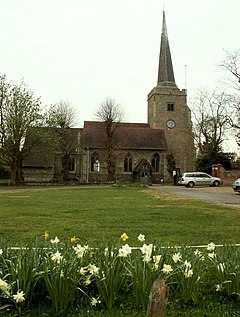Danbury, Essex
| Danbury | |
|---|---|
 St John the Baptist church |
|
| Danbury shown within Essex | |
| Population | 6,500 |
| OS grid reference | TL783050 |
| District | |
| Shire county | |
| Region | |
| Country | England |
| Sovereign state | United Kingdom |
| Post town | Chelmsford |
| Postcode district | CM3 |
| Dialling code | 01245 |
| Police | Essex |
| Fire | Essex |
| Ambulance | East of England |
| EU Parliament | East of England |
| UK Parliament | |
Danbury is a village in the borough of Chelmsford, Essex, England. It is located 33.5 miles (53.9 km) northeast of Charing Cross, London and has a population of 6,500. It is situated on a hill 367 feet (112 m) above sea level.
The village was built on the site of a Neolithic or early Iron Age hill fort noted for its oval shape, sometimes confused with the Megalithic enclosure at Danebury in Hampshire.
According to the official parish publication, Danbury Parish Plan 2003, first Iron Age settlers, then the Romans and finally the Dæningas tribe of Saxons occupied the Danbury area.
The place-name 'Danbury' is first attested as Danengeberia in the Domesday Book of 1086. The name means 'the burgh or fort of Dene's people'. The same name is the origin of Dengie in Essex.
After the Norman Conquest, King William took the lands and settlement and granted it to Geoffrey de Mandeville, who was made Earl of Essex.
In medieval times Danbury developed from two manors, St Cleres/Herons and Runsell. Traces of both still exist. There was also a small part of a third, now extinct, manor of Gibcracks. The church of St John the Baptist is the oldest building in the village, dating from the 13th century, and is grade I listed. There is a local folk tale that the church's spire was damaged by the Devil in the guise of a monk in the year 1402. According to the legend, the Devil passed between the legs of a parishioner as he departed, and the man later died of a wasting disease.
The village has a long connection with the Sinclair family, known locally as St Clere. There are three wooden effigies in the church which date back to the thirteenth and fourteenth century One has been identified as being that of William St Clere. In 1968 it was taken to be exhibited at the Louvre in Paris.
...
Wikipedia

